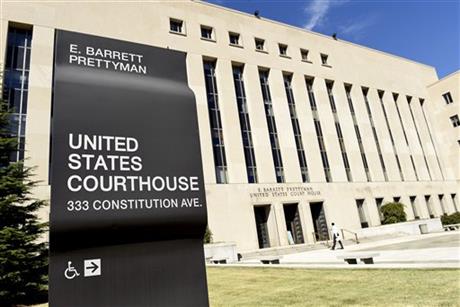
By ERIC TUCKER
An appeals court is deciding whether deputy U.S. marshals who shot and wounded a teenage driver eight years ago may be sued in federal court, a case that’s unfolding amid a national debate about police use of force and the legal protections afforded to law enforcement.
The U.S. Court of Appeals for the District of Columbia Circuit heard arguments last month and could issue an opinion soon.
The case of driver Michael Fenwick raises questions about how police can deal with fleeing individuals and the role video should play in analyzing a police pursuit. A similar case was decided by the U.S. Supreme Court last year after fascinated justices watched dashboard camera video of the chase.
The key issue for the appeals court is whether the deputies are entitled to qualified immunity, a legal principle that shields government officials from being sued unless their actions violate clearly established constitutional rights. A lower-court judge in 2013 allowed the case to go forward, saying there were legitimate questions about whether excessive force was used, but rejected many other arguments from Fenwick’s lawyer.
An appeals court ruling in favor of the marshals would end the case. But if the judges prove sympathetic to arguments that the shooting was unjustified, the case would be returned to the trial court, where it could ultimately reach a jury and add to a body of law that is still developing. That’s a potentially heavy legal burden, given past court decisions that give law enforcement leeway in firing at fleeing suspects if they feel endangered.
The Jan. 3, 2007, shooting occurred when deputy marshals serving an eviction notice at a Washington, D.C., apartment complex came upon a 16-year-old they suspected of having stolen a car.
Fenwick, who was unarmed and was at the apartment complex to visit his girlfriend, got back into his car even as one of the deputies tried to speak with him, backed out of the parking space and then, as deputies moved to surround the vehicle, drove forward toward at least one of the officers, according to the government’s account.
The Justice Department, which is defending the two deputies being sued, says Fenwick was shot only after he struck one of the deputies with his car. The government says the force was reasonable and that the case should be dismissed.
But Fenwick’s lawyer, David Shurtz, says his client was shot four times, starting as he was simply trying to back up, not drive forward. And he said that there was no probable cause to try to stop him in the first place.
“He was on the verge of death,” Shurtz said of his wounds. “This was not any lightweight injury.”
A judge in a juvenile court proceeding found Fenwick responsible for assaulting an officer. But when Fenwick sued in federal court, U.S. District Judge Paul Friedman said the facts of the case were enough in dispute — including whether the deputies reasonably believed themselves to be in danger at the time they fired — that he allowed the case to go forward while limiting the scope of Fenwick’s arguments.
Both sides appealed.
In a digital era when police actions are increasingly recorded, Shurtz is urging the court to take into account surveillance video from the apartment complex that he contends supports his position. Friedman considered the video inconclusive, but now Shurtz wants the court judges to consider a reformatted version of the video that isolates the sequence frame by frame, revealing the action by fractions of a second and allowing a viewer to see the events unfold on multiple screens at the same time.
Fenwick’s mother initially sued on his behalf in 2007 because her son was a juvenile. Fenwick is now the named plaintiff in the case but is imprisoned out-of-state for a weapons crime, Shurtz said.
The case comes on the heels of racially charged episodes of police force in Ferguson, Missouri and New York, and also as courts grapple with questions of force against those fleeing capture.
The seminal Supreme Court decision in such cases, Tennessee vs. Garner from 1985, held that officers may not use deadly force to stop a fleeing suspect unless the suspect poses significant harm to the officer or others. Since then, though, victims of police shootings have tested that standard in courts nationwide, requiring judges to consider challenges that have their own specific circumstances.
Last May, the Supreme Court overturned a lower court’s opinion and sided with police officers in Arkansas who were sued over a high-speed, two-state chase that ended with the deaths of the fleeing driver and his passenger after police fired 15 shots into the fleeing car.
“There are a lot of questions that are fact-specific, and courts look at things differently,” said Geoffrey Alpert, a University of South Carolina expert on police use of force.
____



